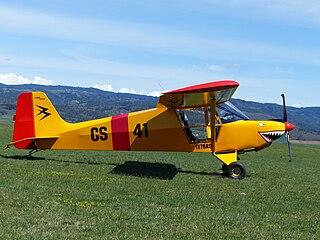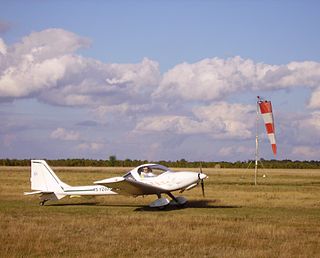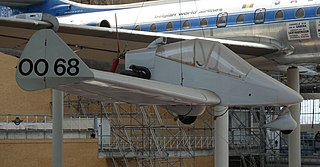
The Civilian Coupé is a British, single-engined two-seat private monoplane built starting in 1929. Only five were made and it was the Civilian Aircraft Company's only product, but one still flies in the UK.

The Lamco Eurocub is a Hungarian ultralight aircraft with fixed conventional landing gear, manufactured by Danex Engineering Kft. It is used primarily for flight training, touring and personal flying.

The Nicollier Menestrel family of French homebuilt low-wing single-engine light aircraft includes both single- and two-seat variants and a wide choice of engines. First flown in 1962, nearly 100 have been built and others remain under construction.

The Dyn'Aéro CR.100 is a French kit built single engine, two-seat monoplane, developed in the 1990s and intended as both an aerobatic trainer and a tourer, primarily for aero club use.
The RemSchetMash RSM-15 Robust is a single-seat, single-engine ultralight built in Ukraine. It first flew in 2006 but no production aircraft had been produced by late 2009.

The TL Ultralight TL-132 Condor and TL-232 Condor Plus are single engine, highwing ultralight aircraft designed and built in the Czech Republic in the mid-1990s. They remain in production in 2010.
The Dorna D-139 Parandeh Abi is a low-wing single-engine monoplane built from composite materials in Iran. It is a recreational and training aircraft with side-by-side seating.

The Roko Aero NG4 is a single-engined sport aircraft, available in both light-sport aircraft and ultralight models, which seats two side by side. It is in production in the Czech Republic.

The Kellner-Béchereau EC.4 and Kellner-Béchereau ED.5 were a pair of French training aircraft with side-by-side seating and a novel "double wing" patented by their designer, Louis Béchereau. The principal difference was that the EC.4 had an all-wood structure whereas the ED.5 was all-metal. Both were single-engine, mid-wing cantilever monoplanes.
The Eurofly FB5 Star Light is a single engine kit built Italian ultralight, seating two side by side. It first flew in the late 2000s.

The Humbert Tétras is a French two seat ultralight with a single engine and high wing. Available as a kit or complete aircraft, it has been in production since 1994 by Humbert Aviation of Ramonchamp.

The Dallach D.2 Sunrise, also known as the WDFL Sunrise after its suppliers, is a single-engine, single-seat cantilever monoplane. It was designed and marketed as a homebuilt aircraft in Germany by Wolfgang Dallach.

The Groppo XL and Groppo Trail are very similar single engine, tandem seat, high wing ultralight aircraft designed and built in Italy. Both can be supplied complete or in kit form. The two models differ chiefly in undercarriage type.

The Lambert Mission 106 is a conventionally laid out, high-wing ultralight, seating two side-by-side. Designed in Belgium, there are ULM and LSA versions.
The Tisserand Hydroplum is a small amphibious aircraft with a single, pusher engine, built in France in the 1980s. Originally a single-seat, high-wing monoplane, it was developed into a two-seat biplane for production in kit form as the SMAN Pétrel.

The Aviakit Véga is an ultralight aircraft seating two in side-by-side configuration. It was designed in France in the late 1990s to be easily constructed by amateurs from kits and was offered with a choice of three engines and of tricycle or conventional undercarriages.
The ViS Sprint is a pusher configuration, pod-and-boom two-seat ultralight, designed and built in the Ukraine in the mid-2000s. It can serve as an agricultural spraying aircraft.

The French tailless Pottier P.40 was the first aircraft designed by Jean Pottier. It flew in 1975.
The Pottier P.60 Minacro is a homebuilt French single seat biplane designed for aerobatics. It first flew in the early 1990s; about six have been completed.

The Caproni Ca.95 was a large, three engine, long range, heavy bomber prototype built in Italy in 1929. It could carry a 1,600 kg (3,500 lb) bomb load and had three defensive gun positions. Only one was built.















